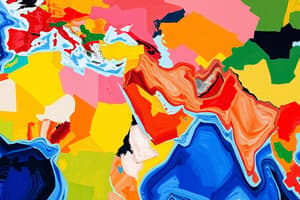Podcast
Questions and Answers
What role did pastoral nomads play in the decline of the Western Roman Empire?
What role did pastoral nomads play in the decline of the Western Roman Empire?
Pastoral nomads formed mounted armies that attacked southward, disrupting trade along the Silk Road and contributing to the decline of the Western Roman Empire.
How did the migrations of Bantu-speaking farmers impact sub-Saharan Africa during the turbulent times of 300 to 600 C.E.?
How did the migrations of Bantu-speaking farmers impact sub-Saharan Africa during the turbulent times of 300 to 600 C.E.?
Bantu-speaking farmers migrated south, establishing urban communities and integrating with older populations, ultimately expanding trade networks.
In what ways did the expansion of trade across the Sahara Desert affect African societies during this period?
In what ways did the expansion of trade across the Sahara Desert affect African societies during this period?
The expansion led to the emergence of commercial kingdoms like Ghana and Aksum, enhancing trade and cultural exchange across the region.
What impact did the disruptions of the Silk Road between 300 and 600 C.E. have on urban development within Afroeurasia?
What impact did the disruptions of the Silk Road between 300 and 600 C.E. have on urban development within Afroeurasia?
What geographic regions were primarily influenced by the migrations of the pastoral nomads?
What geographic regions were primarily influenced by the migrations of the pastoral nomads?
Flashcards are hidden until you start studying
Study Notes
Empires of Afroeurasia
- Four major empires dominated Afroeurasia: the Roman Empire, Sasanian Persian Empire, Gupta Empire, and the Chinese Empire.
- Empires are extensive territories governed by a single ruler or authority.
Impact of Pastoral Nomads
- Pastoral nomads, reliant on livestock, migrated northward influencing regions of China, India, Persia, and Rome.
- Many nomads created mounted armies that attacked southern empires, disrupting trade routes including the Silk Road.
- Disruptions between 300 and 600 C.E. contributed to the decline of significant empires: Han, Parthian, and Western Roman.
Decline of Urban Centers
- The number of cities in the Roman Empire decreased from approximately 75 in 100 C.E. to around 47 by 500 C.E.
- Increased instability led to turbulent times for populations globally.
Flourishing African Societies
- Despite declines in some empires, African societies thrived during this era.
- Trade across the Sahara Desert increased, leading to the rise of commercial kingdoms like Ghana and Aksum.
- Aksum emerged as a key trade hub for Indian Ocean commerce.
Cultural Exchanges and Migration
- Expanded trade routes facilitated the transmission of religious ideas and cultural exchanges across Afroeurasia.
- Bantu-speaking farmers migrated south from sub-Saharan Africa, establishing urban communities and enhancing trade networks.
- Interaction between Bantu farmers and older populations involved displacement and cultural mixing.
Polynesian Exploration
- Polynesian explorers navigated vast distances using canoes, contributing to expansion across the Pacific Islands.
The Fall of Rome
- In 410 C.E., a Germanic tribe attacked Rome, marking a significant event in the decline of the Western Roman Empire.
Studying That Suits You
Use AI to generate personalized quizzes and flashcards to suit your learning preferences.




